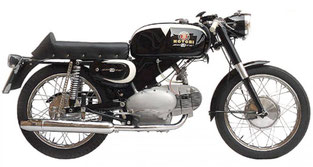
MOTOBI Motorcycle Manual PDF
History of MotoBi Motorcycles
A MOTOBI Motorcycle PDF Owner's Manual above the page.
After a family disagreement in 1948, Giuseppe Benelli, one of the six brothers and an engineer of some talent, decided to go his own way.
Giuseppe started the Moto Bi privateer selling small two-stroke motorcycles and scooters.
In 1953 Motobi introduced the 200cc, horizontal two-stroke twin called the B200 Spring Durability.
Its innovative pressed steel construction and horizontal cylindrical arrangement were to become a trademark for many future Motobi bikes.
The B200 engine was a clean, streamlined, highly modern emerging unit that was soon named "egg" for its distinctive shape.
Giuseppe and his sons Luigi and Marco continued to work on improving Motobi products and envisioned a four-stroke engine, a single-cylinder variant of the B200.
In late 1955, the B200 twin two-stroke cylinder was abandoned entirely, and two different new models, both called Catria were introduced, one at 125cc and the other at 175cc.
Both were four-stroke four speed singles designed by freelance engineer Piero Prampolini.
These improved singles became the center of Motobi production, beating the Moto Aermacchi 175cc chimera (which had a similar horizontal single cylinder engine configuration) to the market for a year.
Not long after, Giuseppe Benelli died, leaving the company in the hands of his two heirs. Once heading the company, they hired a young former race car driver and tuner called Prima Zanzani to design a new Catria for a factory racing motorcycle.
Italian semi-pro road racing (named MSDS for Moto Sports Derivative dalla Serie) and climbing road races were popular and the tough little bike soon earned a reputation among Italian riders who called it the "egg of power".
Flamboyant decals praising Motobi racing championships began to appear on the gas tanks of small bikes, each version more colorful than the last.
Benelli's company saw an opportunity in the USA, and also right next door, under the roof of their little cousin, Motobi.
Motobi was acquired by the larger Benelli company in 1962, a move that will not only bring the family back together under the name Gruppo Benelli-Motobi, but also inflate a workforce of approximately 550 employees and increase production to the famous 300 machines per day.
Many of these machines were exported to the United States, badged as Benelli models.


